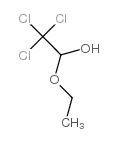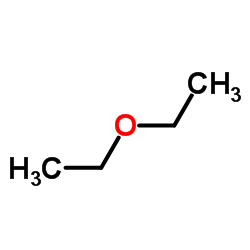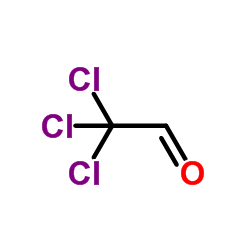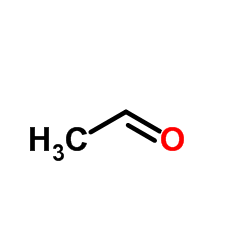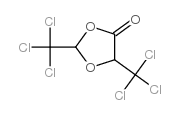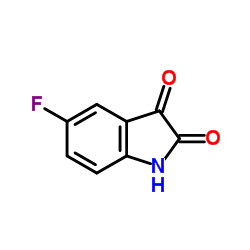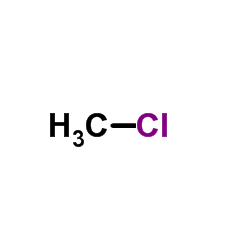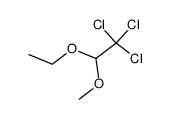515-83-3
| 中文名 | 2,2,2-三氯-1-乙氧基乙醇 |
|---|---|
| 英文名 | 2,2,2-trichloro-1-ethoxyethanol |
| 中文别名 |
二乙醇縮氯醛
三氯-1-乙氧基乙醇 |
| 英文别名 |
Chloral alcoholate
EINECS 208-211-1 1-ethoxy-2,2,2-trichloro-ethanol Chloral-monoaethylacetal trichloroacetaldehyde ethyl hemiacetal Chloral ethylalcoholate Ethanol chloral hemiacetal ETHANOL,2,2,2-TRICHLORO-1-ETHOXY MFCD00013668 Chloral semiacetal 2,2':6',2''-TERPYRIDINE-4'-PHOSPHONIC ACID 1-Aethoxy-2,2,2-trichlor-aethanol 2,2,2-Trichloro-1-ethoxyethanol Trichloroacetaldehyde monoethylacetal Chloral,ethyl hemiacetal |
| 密度 | 1.454 g/cm3 |
|---|---|
| 沸点 | 116ºC at 760 mmHg |
| 熔点 | 47ºC |
| 分子式 | C4H7Cl3O2 |
| 分子量 | 193.45600 |
| 闪点 | 48.9ºC |
| 精确质量 | 191.95100 |
| PSA | 29.46000 |
| LogP | 1.71150 |
| 外观性状 | 白色至淡黄色结晶粉末 |
| 折射率 | 1.488 |
| 储存条件 | 储存于阴凉、干燥、通风良好的库房。远离火种、热源。防止阳光直射。包装密封。应与酸类、食用化学品分开存放,切忌混储。储区应备有合适的材料收容泄漏物。 |
| 稳定性 | 按规格使用和贮存,不会发生分解,避免与氧化物接触 |
| 分子结构 | 1、 摩尔折射率:38.33 2、 摩尔体积(m3/mol):133.0 3、 等张比容(90.2K):335.4 4、 表面张力(dyne/cm):40.4 5、 极化率(10 -24cm 3):15.19 |
| 计算化学 | 1.疏水参数计算参考值(XlogP):1.8 2.氢键供体数量:1 3.氢键受体数量:2 4.可旋转化学键数量:2 5.互变异构体数量:无 6.拓扑分子极性表面积29.5 7.重原子数量:9 8.表面电荷:0 9.复杂度:80.4 10.同位素原子数量:0 11.确定原子立构中心数量:0 12.不确定原子立构中心数量:1 13.确定化学键立构中心数量:0 14.不确定化学键立构中心数量:0 15.共价键单元数量:1 |
| 更多 | 1. 性状:固体结晶 2. 密度(g/ cm3,25/4℃):1.143 3. 相对蒸汽密度(g/cm3,空气=1):未确定 4. 熔点(ºC):47.5 5. 沸点(ºC,常压):116 6. 沸点(ºC,8kPa):未确定 7. 折射率:未确定 8. 闪点(ºC):116 9. 比旋光度(º):未确定 10. 自燃点或引燃温度(ºC):未确定 11. 蒸气压(kPa,25ºC):未确定 12. 饱和蒸气压(kPa,60ºC):未确定 13. 燃烧热(KJ/mol):未确定 14. 临界温度(ºC):未确定 15. 临界压力(KPa):未确定 16. 油水(辛醇/水)分配系数的对数值:未确定 17. 爆炸上限(%,V/V):未确定 18. 爆炸下限(%,V/V):未确定 19. 溶解性:溶于水、乙醇 |
Synonym:Chloral alcoholate; Chloral ethyl hemiacetal; Chloral Ethylalcoholate; Trichloroacetaldehyde Monoethylacetal Section 2 - COMPOSITION, INFORMATION ON INGREDIENTS
Risk Phrases: 22 Section 3 - HAZARDS IDENTIFICATION EMERGENCY OVERVIEW
Harmful if swallowed. Potential Health Effects Eye: May cause eye irritation. Skin: May cause skin irritation. Ingestion: May cause irritation of the digestive tract. May be harmful if swallowed. Inhalation: May cause respiratory tract irritation. Chronic: No information found. Section 4 - FIRST AID MEASURES Eyes: Flush eyes with plenty of water for at least 15 minutes, occasionally lifting the upper and lower eyelids. Get medical aid immediately. Skin: Get medical aid. Flush skin with plenty of water for at least 15 minutes while removing contaminated clothing and shoes. Wash clothing before reuse. Ingestion: If victim is conscious and alert, give 2-4 cupfuls of milk or water. Never give anything by mouth to an unconscious person. Get medical aid. Inhalation: Remove from exposure and move to fresh air immediately. If not breathing, give artificial respiration. If breathing is difficult, give oxygen. Get medical aid. Notes to Physician: Antidote: None reported. Section 5 - FIRE FIGHTING MEASURES General Information: As in any fire, wear a self-contained breathing apparatus in pressure-demand, MSHA/NIOSH (approved or equivalent), and full protective gear. During a fire, irritating and highly toxic gases may be generated by thermal decomposition or combustion. Extinguishing Media: Use water spray, dry chemical, carbon dioxide, or appropriate foam. Section 6 - ACCIDENTAL RELEASE MEASURES General Information: Use proper personal protective equipment as indicated in Section 8. Spills/Leaks: Clean up spills immediately, observing precautions in the Protective Equipment section. Sweep up or absorb material, then place into a suitable clean, dry, closed container for disposal. Avoid generating dusty conditions. Provide ventilation. Section 7 - HANDLING and STORAGE Handling: Wash thoroughly after handling. Remove contaminated clothing and wash before reuse. Use with adequate ventilation. Minimize dust generation and accumulation. Avoid contact with eyes, skin, and clothing. Keep container tightly closed. Avoid ingestion and inhalation. Storage: Keep container closed when not in use. Store in a tightly closed container. Store in a cool, dry, well-ventilated area away from incompatible substances. Section 8 - EXPOSURE CONTROLS, PERSONAL PROTECTION Engineering Controls: Use adequate ventilation to keep airborne concentrations low. Exposure Limits CAS# 515-83-3: Personal Protective Equipment Eyes: Wear appropriate protective eyeglasses or chemical safety goggles as described by OSHA's eye and face protection regulations in 29 CFR 1910.133 or European Standard EN166. Skin: Wear appropriate protective gloves to prevent skin exposure. Clothing: Wear appropriate protective clothing to prevent skin exposure. Respirators: Follow the OSHA respirator regulations found in 29 CFR 1910.134 or European Standard EN 149. Use a NIOSH/MSHA or European Standard EN 149 approved respirator if exposure limits are exceeded or if irritation or other symptoms are experienced. Section 9 - PHYSICAL AND CHEMICAL PROPERTIES Physical State: Crystals Color: Not available. Odor: None reported. pH: Not available. Vapor Pressure: Not available. Viscosity: Not available. Boiling Point: 116 deg C Freezing/Melting Point: 47.5 deg C Autoignition Temperature: Not available. Flash Point: Not available. Explosion Limits, lower: Not available. Explosion Limits, upper: Not available. Decomposition Temperature: Solubility in water: Slightly soluble. Specific Gravity/Density: Molecular Formula: C4H7Cl3O2 Molecular Weight: 193.46 Section 10 - STABILITY AND REACTIVITY Chemical Stability: Stable under normal temperatures and pressures. Conditions to Avoid: Incompatible materials, dust generation, strong oxidants. Incompatibilities with Other Materials: Strong oxidizing agents. Hazardous Decomposition Products: Irritating and toxic fumes and gases, chloride fumes. Hazardous Polymerization: Has not been reported. Section 11 - TOXICOLOGICAL INFORMATION RTECS#: CAS# 515-83-3: KM4725000 LD50/LC50: CAS# 515-83-3: Oral, rat: LD50 = 880 mg/kg. Carcinogenicity: 2,2,2-Trichloro-1-ethoxyethanol - Not listed by ACGIH, IARC, or NTP. Other: See actual entry in RTECS for complete information. Section 12 - ECOLOGICAL INFORMATION Other No information available. Section 13 - DISPOSAL CONSIDERATIONS Dispose of in a manner consistent with federal, state, and local regulations. Section 14 - TRANSPORT INFORMATION IATA Not regulated as a hazardous material. IMO Not regulated as a hazardous material. RID/ADR Not regulated as a hazardous material. Section 15 - REGULATORY INFORMATION European/International Regulations European Labeling in Accordance with EC Directives Hazard Symbols: XN Risk Phrases: R 22 Harmful if swallowed. Safety Phrases: S 28A After contact with skin, wash immediately with plenty of water. S 37 Wear suitable gloves. S 45 In case of accident or if you feel unwell, seek medical advice immediately (show the label where possible). WGK (Water Danger/Protection) CAS# 515-83-3: No information available. Canada CAS# 515-83-3 is listed on Canada's NDSL List. CAS# 515-83-3 is not listed on Canada's Ingredient Disclosure List. US FEDERAL TSCA CAS# 515-83-3 is listed on the TSCA inventory. SECTION 16 - ADDITIONAL INFORMATION N/A |
|
生态学数据: 该物质对环境可能有危害,对水体应给予特别注意。 CHEMICAL IDENTIFICATION
HEALTH HAZARD DATAACUTE TOXICITY DATA
|
| 危害码 (欧洲) | Xn: Harmful; |
|---|---|
| 风险声明 (欧洲) | R22 |
| 安全声明 (欧洲) | 23-36/37 45 28A |
| 海关编码 | 2911000000 |
| 上游产品 10 | |
|---|---|
| 下游产品 9 | |
| 海关编码 | 2911000000 |
|---|---|
| 中文概述 | 2911000000 缩醛及半缩醛,不论是否含其他含氧基,及其卤化,磺化,硝化和亚硝化衍生物。监管条件:无。增值税率:17.0%。退税率:9.0%。最惠国关税:5.5%。普通关税:30.0% |
| 申报要素 | 品名, 成分含量, 用途 |
| Summary | 2911000000 acetals and hemiacetals, whether or not with other oxygen function, and their halogenated, sulphonated, nitrated or nitrosated derivatives。Supervision conditions:None。VAT:17.0%。Tax rebate rate:9.0%。MFN tariff:5.5%。General tariff:30.0% |


